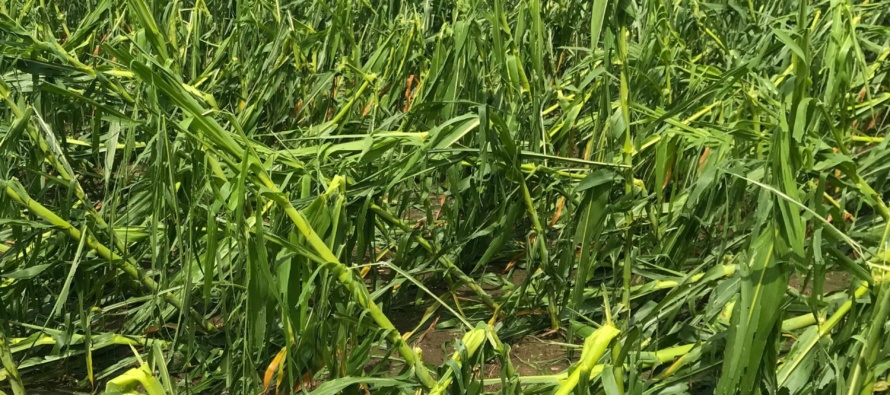Corn Hail Damage and other Storm Issues

Related Articles
- 2010 Soybean And Corn Variety Trial Data 3
- Spring Nitrogen Fertility Suggestions for Wheat 0
- 2010 Row Crop Short Course Video Links 0
Latest Tweets
Fields in numerous areas of the state have taken a beating from hail and wind associated with recent storms. Several different types of corn damage may have occurred depending upon the type of storm, including hail damage, lodging and greensnap.
 Damage and yield loss associated with hail is primarily related to the loss of leaf area. This damage hurts corn yield potential because it reduces its capacity to photosynthesize and produce energy. However, only leaf area completely removed from the plant or dead is considered defoliated for yield loss assessment purposes. Considerably more corn leaf area will be stripped and otherwise mutilated, but if this leaf tissue remains alive and green, it is not considered to be defoliated.
Damage and yield loss associated with hail is primarily related to the loss of leaf area. This damage hurts corn yield potential because it reduces its capacity to photosynthesize and produce energy. However, only leaf area completely removed from the plant or dead is considered defoliated for yield loss assessment purposes. Considerably more corn leaf area will be stripped and otherwise mutilated, but if this leaf tissue remains alive and green, it is not considered to be defoliated.
The degree of corn yield reduction resulting from hail damage also depends greatly on crop growth stage. Unfortunately, corn at or near tassel is most vulnerable to defoliation because all leaves have emerged and corn is extremely sensitive to photosynthetic energy during early reproductive stages. Thus, corn is generally most sensitive to hail damage at or near tassel stage with the yield loss resembling a bell-shaped curve on either side of tassel. As kernels develop and progress towards maturity, corn plants will more readily allocate stored energy to kernels, making yield reduction resulting from defoliation less substantial, compared to the early reproductive stages. Vegetative corn plants young enough to not have upper leaves emerged should at least have a few leaves and the tassel protected which will should continue to develop normally.

 Greensnap is a term describing corn stalks completely broken off by high winds. This catastrophic event usually occurs during rapid vegetative growth stages anytime from when corn is two feet tall until nearly tassel. Greensnap is much more common in the windy plains states, but Mississippi corn has occasionally suffered issues, including during recent years. During mid to late vegetative stages the stalk is rapidly developing and may be somewhat brittle, because it does not possess the rigidity it will have when development is complete. Stalk breakage normally occurs well below where the ear normally develops. Therefore, yield reduction is closely correlated with the percentage of snapped stalks. The most practical method to limit risk is to select hybrids resistant to greensnap, as considerable differences exist. However, be aware that greensnap resistance is likely completely independent of stalk strength during harvest, since this condition exists during a drastically different developmental and time period. Several other cultural factors, including high nutrient levels, in-season nitrogen application, row orientation perpendicular to the wind direction, high plant population, plentiful soil moisture and irrigation timing may also influence greensnap.
Greensnap is a term describing corn stalks completely broken off by high winds. This catastrophic event usually occurs during rapid vegetative growth stages anytime from when corn is two feet tall until nearly tassel. Greensnap is much more common in the windy plains states, but Mississippi corn has occasionally suffered issues, including during recent years. During mid to late vegetative stages the stalk is rapidly developing and may be somewhat brittle, because it does not possess the rigidity it will have when development is complete. Stalk breakage normally occurs well below where the ear normally develops. Therefore, yield reduction is closely correlated with the percentage of snapped stalks. The most practical method to limit risk is to select hybrids resistant to greensnap, as considerable differences exist. However, be aware that greensnap resistance is likely completely independent of stalk strength during harvest, since this condition exists during a drastically different developmental and time period. Several other cultural factors, including high nutrient levels, in-season nitrogen application, row orientation perpendicular to the wind direction, high plant population, plentiful soil moisture and irrigation timing may also influence greensnap.
 High winds may also cause stalks to blow down during the season. This is a variation of what we typically refer to as “root lodging,” which normally occurs late in the season near physiological maturity. However, if this occurs during the season, plants will attempt to right themselves. Their ability to stand back up is generally much better the younger plants are, as smaller, lighter stalks are easier to re-orient. Plants normally compensate as much as they can within a week or so following a windstorm. The lower stalk often goose-necks or bends, if the stalk is too heavy to completely right itself.
High winds may also cause stalks to blow down during the season. This is a variation of what we typically refer to as “root lodging,” which normally occurs late in the season near physiological maturity. However, if this occurs during the season, plants will attempt to right themselves. Their ability to stand back up is generally much better the younger plants are, as smaller, lighter stalks are easier to re-orient. Plants normally compensate as much as they can within a week or so following a windstorm. The lower stalk often goose-necks or bends, if the stalk is too heavy to completely right itself.




Let me tell You a sad story ! There are no comments yet, but You can be first one to comment this article.
Write a comment